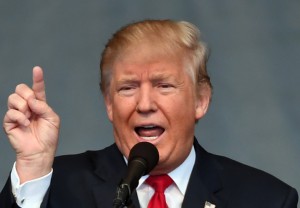
The Trump administration outlined its list of priorities for the upcoming negotiations with Canada and Mexico over NAFTA.
The Trump administration fired its first salvo in the renegotiation of the North American Free Trade Agreement by informing U.S. lawmakers it plans to shrink the trade imbalance between the U.S. and Canada and Mexico.
The 17-page document is the first look at the “agenda” for the talks, which are expected to get underway next month. The early look has some items that may seem like they’re going to make automakers happy.
One of the first items pushes the idea that none of the countries should manipulate their currently to gain an advantage on the exchange rate. Japan and China have been accused of this tactic in the past, however, this is not currently an issue with either Canada or Mexico. That said, the administration did receive some support for this measure.
“Foreign currency manipulation is the 21st century trade barrier, and we strongly support the inclusion of this top-tier issue in the U.S. negotiating objectives for NAFTA,” said Ford Motor Co. in a statement to Reuters.
(Mexico auto exports to U.S. reach record high in June. For more, Click Here.)
In addition, the administration will attempt to strengthen NAFTA’s rules of origin to ensure those benefits do aid countries outside the agreement. Additionally, negotiators will seek “incentivize” the sourcing of U.S. goods. No details were provided on how that might be done.
Noticeably absent from the list of priorities were punitive tariffs, which was welcome news to Mexican officials, Reuters reported.
While the automakers will be happy with the moves on currency manipulation and pushing for more U.S. sourcing, one trade issue they are unlikely to be happy about is a new steel tariff that is being proposed.
The Trump administration is suggesting it may put a tariff on imported steel in an effort to stem the tide of cheaper Chinese steel that U.S. steelmakers cannot keep pace with. Currently, automakers buy most of their steel from U.S. producers; however, there is a concern that once the tariff is in place, U.S. steel companies will inflate their prices, putting the squeeze on automaker profits.
(Click Here for the details about the opening of NAFTA renegotiations.)
“Prices will go up and people will buy less,” said Alan Deardorff, professor of public policy and economics at the University of Michigan, told the Detroit News. “It’s ironic that in discouraging imports of steel, he may encourage the imports of cars.”
Additionally, automakers do buy imported steel from China, but also from 109 other countries, including NAFTA partners Canada and Mexico. Automakers buy about 15% of all the steel used in the U.S. each year. Ford Motor Co. buys 95% of its steel from U.S. manufacturers, the Detroit News reported.
“(If) the president were to increase tariffs on foreign steel or impose other import restrictions, the auto industry and the U.S. workers that the industry employs would be adversely affected, and (this) unintended negative impact would exceed the benefit provided to the steel industry from this executive action,” said the American Automotive Policy Council in a document that is part of an ongoing investigation by the U.S. government over steel.
(No change to NAFTA rule of origin Mexico officials say. Click Here for the story.)
The group, which represents Ford, Fiat Chrysler and General Motors, added that the end result of tariffs would be higher steel prices for automakers, which would need to be passed on to consumers in the form of higher prices for new vehicles. Inevitably, this would cause sales to drop in the U.S. and fewer exports of U.S.-built vehicles outside the country, hurting the automakers and its workers.
